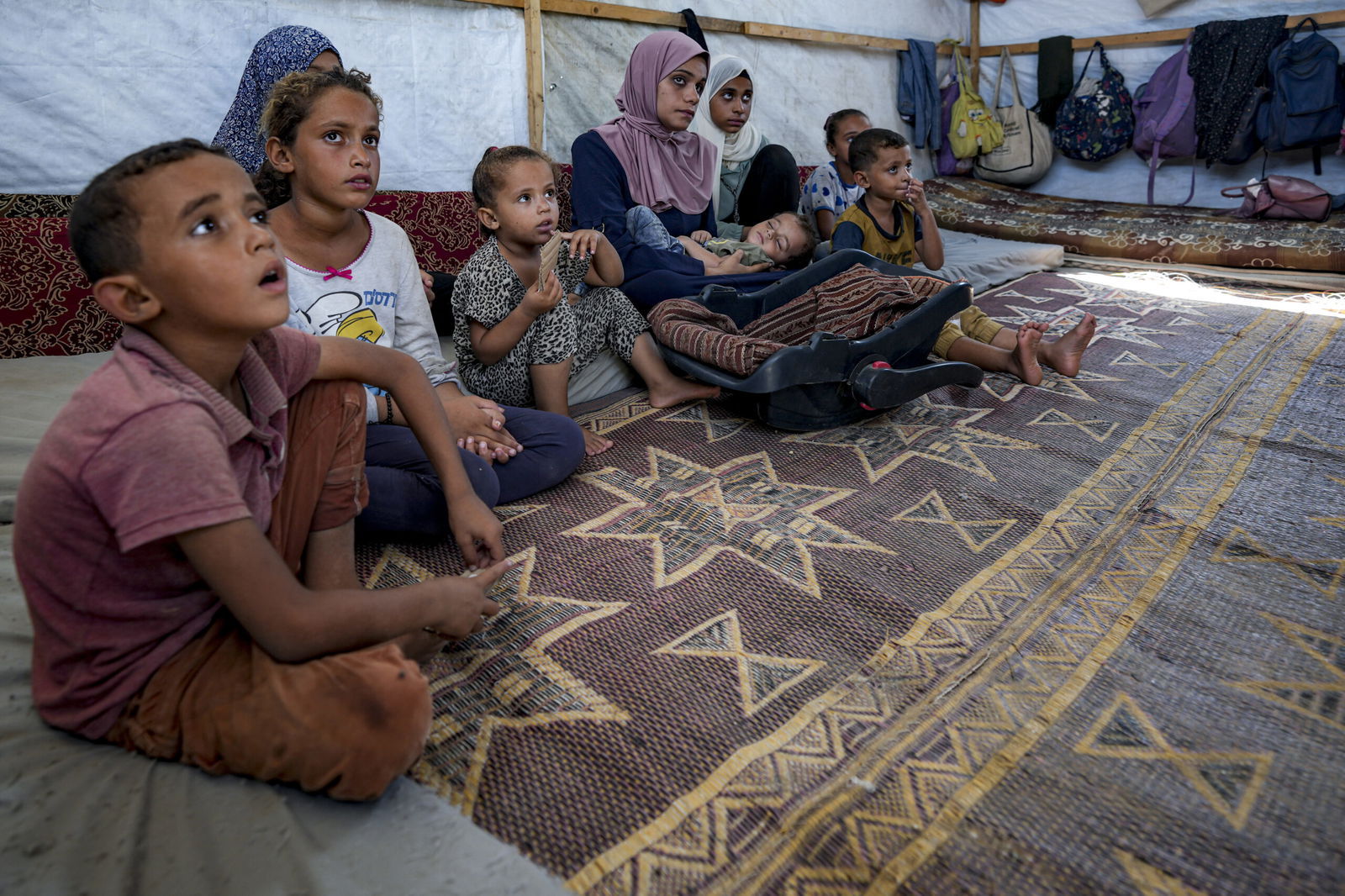Around the World briefs

By Associated Press
A baby in Gaza has a strain of polio linked to mistakes in eradication campaign, experts say
LONDON | The baby in Gaza who was recently paralyzed by polio was infected with a mutated strain of the virus that vaccinated people shed in their waste, according to scientists who say the case is the result of “an unqualified failure” of public health policy.
The infection, which marked the first detection of polio in the war-torn Palestinian territory in more than 25 years, paralyzed the lower part of one leg in the unvaccinated 10-month-old child. The baby boy was one of hundreds of thousands of children who missed vaccinations because of the fighting between Israel and Hamas.
Scientists who have been monitoring polio outbreaks said the baby’s illness showed the failures of a global effort by the World Health Organization and its partners to fix serious problems in their otherwise largely successful eradication campaign, which has nearly wiped out the highly infectious disease. Separately, a draft report by experts deemed the WHO effort a failure and “a severe setback.”
The polio strain in question evolved from a weakened virus that was originally part of an oral vaccine credited with preventing millions of children worldwide from being paralyzed. But that virus was removed from the vaccine in 2016 in hopes of preventing vaccine-derived outbreaks.
Public health authorities knew that decision would leave people unprotected against that particular strain, but they thought they had a plan to ward off and quickly contain any outbreaks. Instead, the move resulted in a surge of thousands of cases.
“It was a really horrible strategy,” said Columbia University virologist Vincent Racaniello, who was not involved with the report or the WHO. “The decision to switch vaccines was based on an incorrect assumption, and the result is now we have more polio and more paralyzed children.”
A draft copy of the report commissioned by the WHO and independent experts said the plan underestimated the amount of the strain in the environment and overestimated how well officials would be able to squash outbreaks.
The plan led to vaccine-linked polio outbreaks in 43 countries that paralyzed more than 3,300 children, the report concluded.
Even before the Gaza case was detected, officials reviewing the initiative to tinker with the vaccine concluded that “the worst-case scenario has materialized,” the report said.
The report has not yet been published, and some changes will likely be made before the final version is released next month, the WHO said.
The strain that infected the baby in Gaza had lingered in the environment and mutated into a version capable of starting outbreaks. It was traced to polio viruses spreading last year in Egypt, according to genetic sequencing, the WHO said.
In 2022, vaccine-linked polio viruses were found to be spreading in Britain, Israel and the U.S., where an unvaccinated man was paralyzed in upstate New York.
Scientists now worry that the emergence of polio in a war zone with an under-immunized population could fuel further spread.
Racaniello said the failure to track polio carefully and to sufficiently protect children against the strain removed from the vaccine has had devastating consequences.
“Only about 1% of polio cases are symptomatic, so 99% of infections are silently spreading the disease,” he said.
The oral polio vaccine, which contains a weakened live virus, was withdrawn in the U.S. in 2000. Doctors continued to vaccinate children and eventually moved to an injected vaccine, which uses a dead virus and does not come with the risk that polio will be present in human waste. Such waste-borne virus could mutate into a form that triggers outbreaks in unvaccinated people.
The report’s authors faulted leaders at the WHO and its partners, saying they were unable or unwilling “to recognize the seriousness of the evolving problem and take corrective action.”
WHO spokesman Oliver Rosenbauer acknowledged that the vaccine strategy “exacerbated” the risk of epidemics linked to the vaccine.
He said in an email that immunization “was not implemented in such a way to rapidly stop outbreaks or to prevent new strains from emerging.” Rosenbauer said not hitting vaccination targets was the biggest risk for allowing vaccine-linked viruses to emerge.
“You need to reach the children with the vaccines … regardless of which vaccines are used,” he said.
The WHO estimates that 95% of the population needs to be immunized against polio to stop outbreaks. The U.N. health agency said only about 90% of Gaza’s population was vaccinated earlier this year.
To try to stop polio in Gaza and the wider region, the WHO and its partners plan two rounds of vaccination campaigns later this week and next month, aiming to cover 640,000 children. Authorities will use a newer version of the oral polio vaccine that targets the problematic strain. The weakened live virus in the new vaccine is less likely to cause vaccine-derived outbreaks, but they are still possible.
Racaniello said it was “unethical” that the WHO and its partners were using a vaccine that is unlicensed in rich countries precisely because it can increase the risk of polio in unvaccinated children.
The oral polio vaccine, which has reduced infections globally by more than 99%, is easy to make and distribute. Children require just two drops per dose that can be administered by volunteers. The oral vaccine is better at stopping transmission than the injected version, and it is cheaper and easier to administer.
But as the number of polio cases caused by the wild virus have plummeted in recent years, health officials have been struggling to contain the increasing spread of vaccine-linked cases, which now comprise the majority of polio infections in more than a dozen countries, in addition to Afghanistan and Pakistan, where transmission of the wild virus has never been stopped.
“This is the result of the Faustian bargain we made when we decided to use” the oral polio vaccine, said Dr. Paul Offit, director of the Vaccine Education Center at the University of Philadelphia. “If we really want to eradicate polio, then we need to stop using the vaccine with live (weakened) virus.”
A strong wave likely capsized a Viking replica ship off Norway, police say
COPENHAGEN, Denmark | A strong wave was likely responsible for the capsizing of a Viking ship replica earlier this week off Norway’s coast that killed a U.S. citizen, police said Thursday, describing it as a “tragic accident” that did not constitute a criminal matter.
The wooden replica, called Naddodd, was crossing the North Atlantic from the Faeroe Islands to Norway with an international team of six people. The 33-feet double-masted vessel built on the Faeroes had departed the islands located halfway between Scotland and Iceland on Saturday.
On Tuesday, it sailed into strong winds and high waves and late that night, the ship capsized off the coastal town of Stad, about 215 miles from the capital of Oslo.
Survivors told police that the weather “suddenly turned significantly worse than predicted with very high waves.” Rescuers said some of the waves were up to 16 feet high at the time.
The five survivors had managed to get into an inflatable life raft and were were later airlifted to safety by helicopter. A sixth person, who had been trapped underneath the vessel, drowned, police said. The victim’s body was found on Wednesday.
Police have not released the name of the victim but Norwegian and Faeroese media identified her as 29-year-old archaeologist Karla Dana, from Florida.
“Thrilled to be a part of this crew, fearlessly embarking on this Nordic voyage on a Viking ship replica across the North Sea, pushing through physical and mental limits to sail into history,” Dana had posted on her LinkedIn profile before the trip.
Tropical storm Shanshan lashes Japan with torrential rains and strong winds on its crawl northeast
TOKYO | A strong storm lashed southern Japan with torrential rain and strong winds Thursday, causing at least three deaths as it started a crawl up the length of the archipelago and raised concerns of flooding, landslides and extensive damage.
Tropical storm Shanshan made landfall Thursday morning as a powerful typhoon on the southern island of Kyushu and then gradually lost strength, though it was still forecast to bring strong winds, high waves and significant rainfall to most of the country, particularly on Kyushu.
About 2 feet of rain fell in parts of Miyazaki prefecture on Kyushu, swelling rivers and threatening floods, the Japan Meteorological Agency said. That 24-hour total was more than the average rainfall for all of August, it said.
By late afternoon Thursday, the storm was moving north at 9 mph and its winds had weakened to 67 mph. It is “no longer a powerful typhoon,” the agency said.
As disaster risks in the Kyushu region subsided later Thursday, Shanshan started dumping heavy rain on neighboring Shikoku island.
The storm ripped through downtown Miyazaki city on Kyushu, knocking down trees, throwing cars to the side in parking lots and shattering windows of some buildings. The prefectural disaster management task force said about 50 buildings were damaged.
NHK public television showed a swollen river in the popular hot spring town of Yufu in Oita prefecture, just north of Miyazaki, with muddy water splashing against a bridge.
More than 70 people were injured across Kyushu, mostly in Miyazaki and Kagoshima. Some were injured by being thrown to the ground by the storm on their way to shelters, the Fire and Disaster Management Agency said.
About 168,000 households were without power across Kyushu, most of them in Kagoshima prefecture, Kyushu Electric Power Co. said.
About 20,000 people took shelter at municipal community centers, school gymnasiums and other facilities across Kyushu, according to prefectural reports.
Ahead of the storm’s arrival, heavy rain triggered a landslide that buried a house in the central city of Gamagori, killing three residents and injuring two others, the city’s disaster management department said. On the southern island of Amami, which Shanshan passed, one person was injured by being knocked down by a wind gust while riding a motorcycle, the fire agency said.
Weather and government officials are concerned about extensive damage as the storm slowly sweeps up the Japanese archipelago to the northeast over the next few days, threatening more floods and landslides.
In the Tokyo region, Shinkansen bullet trains connecting Tokyo and Osaka were suspended starting Thursday evening due to heavy rain in the central region. Bullet train service also was to be suspended in parts of the western and central regions on Friday.
Disaster Management Minister Yoshifumi Matsumura said Shanshan could cause “unprecedented” levels of violent winds, high waves, storm surges and heavy rain. At a task force meeting on Wednesday, he urged people, especially older adults, not to hesitate and take shelter whenever there is any safety concern.
Hundreds of domestic flights connecting southwestern cities and islands were canceled Thursday, and bullet trains and some local train services were suspended. As the storm headed northeast, similar steps were taken in parts of the main island of Honshu that were experiencing heavy rain. Postal and delivery services were suspended in the Kyushu region, and supermarkets and other stores planned to close.
An Afghan woman who sings outdoors to protest the Taliban’s morality
laws says she won’t be silenced
ISLAMABAD | A woman who posted a video of herself singing outdoors in Afghanistan to protest the Taliban’s morality laws, which include a ban on women’s voices in public, said Thursday she won’t be silenced.
The 23-year-old graduate is from the northeastern province of Badakhshan and only gave her last name, Efat, to avoid reprisals.
“No command, system or man can close the mouth of an Afghan woman,” she told The Associated Press. “If you close one part of the body of an Afghan woman, another part will work.”
The Taliban last week issued the country’s first set of laws to prevent vice and promote virtue. They include a requirement for a woman to conceal her face, body and voice outside the home.
The laws have triggered widespread condemnation and accusations that the Taliban are erasing women from public life and granting broad powers to enforcers from the Vice and Virtue Ministry. The Taliban reject the accusations.
Afghan women both inside and outside the country have posted videos of themselves singing in protest at the new laws.
Efat’s face is barely visible in the 39-second video, which was recorded by her older sister and posted to social media on Tuesday. She wears a dark top, a light blue scarf and sunglasses. She sings outdoors, an act prohibited under the new laws.
“Because we are in Afghanistan, and the region has less freedom and more fear, if a sound is heard, it will be shut down,” Efat said. “While I was singing, I had the same fear. That if someone heard it, it would be the last time I sang.”
She chose the song because of its message of defiance, protest and strength: “I am not that weak willow that trembles in every wind/I am from Afghanistan/I remember that day when I opened the cage/I took my head out of the cage and sang drunkenly.”
At the end of the video, she says: “A woman’s voice is not intimate.” It’s a direct reference to the Taliban laws and what they say are the reason for a woman’s voice to be concealed outside the home.
“We will remain stronger than before,” she said.
Efat protested in the city and market when the full veil, or burqa, became mandatory. She speaks openly and criticizes the Taliban on her social media pages. The local Taliban have told her family that she should not do this.
“There is obviously fear. But Afghan women carry the same fear in our lives for the freedom of our voice,” she said.
—From AP reports


